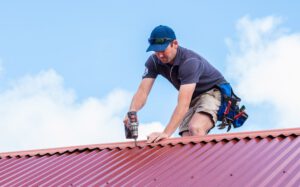Roofing is the process of covering a building with a waterproof membrane. Roofing systems are divided into two main categories: pitched and flat roofs. In most cases, a roof is made up of two layers, which are joined together. They are reinforced with glass-fiber or organic mats. Bitumen is a common adhesive used in roofing and is applied between layers. Roofing materials vary greatly in aesthetics, aesthetic appeal, and technical properties.

Historically, sheet metal has been used for roofing for hundreds of years. Copper has been used to cover cathedrals, and lead is commonly used in older buildings. Lead has a history as a roofing material but was more commonly used as flashing around chimneys and valleys. Slate and clay roofs are a more modern option. Regardless of their aesthetic appeal, however, they have certain limitations. Wood is not a good choice for areas that experience high moisture levels and wildfire risks.
In addition to shingles, roofing materials include metal and asphalt. Metal roofing is usually the most expensive option. It can last for decades, but there is a cost to it. Metal and asphalt-based roofing materials are the most durable. However, they require constant maintenance. If you’re interested in finding a great roof, consider these tips:
The incline of the roof is also an important consideration. The slope of the roof is proportional to the amount of precipitation a given region experiences. A flat roof, for example, is typically less than 3:12 but has a steeper slope. In areas where snow falls heavily, high steeply-pitched roofs are common. The minimum slope for a flat roof is six degrees, while the maximum slope is 30 degrees.
Roofing materials are the most visible components of a roof. Asphalt shingles and roof decking are the most common. Shingles, however, are the most expensive. Metal and rubber are the most commonly flat and sloped roofing materials. However, shingles remain the most popular in homes. If you’re thinking of having a new roof installed, take some time to learn more about the different materials. You can even hire a roofing company to take care of everything.
Asphalt-saturated felt was once the preferred roofing material until about 15 years ago. But now, synthetic products have emerged. Asphalt-saturated felt, also known as tar paper, is made of varying blends of bitumen, polyester, and natural plant fibers. However, it is not waterproof. Hence, it’s best suited for steeply sloped roofs and is not recommended for flat surfaces. It is often the most affordable option.
Lastly, homeowners should understand the terms used in roofing. These terms will help them understand the roof assessment and estimate that will be given to them. Those who are unsure about roofing terminology should take the time to research a roofing company’s credentials. It is a good idea to have a 10% contingency fund that will cover the cost of any roofing project. This money will go a long way in keeping your house dry and comfortable.
Roofing materials come in a variety of styles and textures. Tiles are one of the oldest and most durable roofing materials. For example, mission-style round-topped tiles and flat tiles are popular. While tile is durable and attractive, it is heavy, and you must be sure to check that your house’s structural stability can support the weight of the material. Then, you can install the shingles that match.
Shingles are another common type of roofing material. Typically, they are made of flat, rectangular tiles that overlap at the joints below them. Roofing shingles are available in many different colors, weights, and materials. Natural materials, like wood, slate, and flagstone, can be used to make shingles. Artificial materials can also be used to build roofs, such as slate. The choice of materials for a roof will depend on your climate and desired appearance.
A roof consists of three main components: the eave, the hips, and the valley. Each of these elements has its own name, but the two elements are closely related. Both are important to the roof’s aesthetic appeal. If you’re unsure of which component of a roof system to choose, consult a professional. In addition to shingles, a roof system will determine the type of roof material to use.
Roofing systems made of asphalt and wood shingles can cost between $4.50 and $5 per square foot. Installed properly, a BUR roof can last 20-30 years. EPDM, or rubber roofing, is another common roofing material. It is applied in large sheets, limiting the seams. An EPDM roof can cost anywhere from $4 to $8 per square foot. They’re usually inexpensive to install and last for twenty to thirty years.
